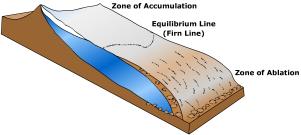Anatomy of a GlacierWhatever the cause, the main reason glacial advances are initiated is
that winter accumulation exceeds the summer loss of snow
over a long period of time. Snow metamorphoses into glacial ice under
the increasing pressure of accumulated layers of snow. It first changes
to a granular form called firn, and ultimately into
ice. Glacial ice sometimes looks blue because it absorbs all colors
of the visible light spectrum except blue, which it transmits and hence
its blue appearance. Glacier ice may also appear white because some ice
is fractured with pockets of air that indiscriminately scatters the
visible light spectrum.
The mass balance of a glacier determines if it will advance across the surface or not. The mass balance is determined by the amount of gain and loss of ice from the glacier. The mass balance is positive when it accumulates more ice than it loses. A glacier has a negative mass balance if it loses more ice than it gains. Glaciers form in the zone of accumulation, the portion of the glacier over which accumulation exceeds ablation. Ablation is the loss of ice (or snow) from the glacier. Ablation includes sublimation, wind erosion, melting, and evaporation. The zone of accumulation for the large continental ice sheets resides at high latitudes. For mountain glaciers, the zone of accumulation is at a high altitude where temperatures are cold prevent complete summertime melt. The zone of ablation is where loss of ice mass is greater than accumulation. The boundary between these two zones is the firn or equilibrium line. If accumulation exceeds ablation the glacier will grow. If ablation exceeds accumulation, the glacier will retreat by melting in place. You can approximate the location of the equilibrium line by examinig an aerial photograph. The glacier looks “dirtier” below the equilibrium line as glacial sediment is exposed on top of the ice. Above the line it is more white because fresh snow usually covers the surface. Listen to a glacier refreezing (Antarctica 2000). |


